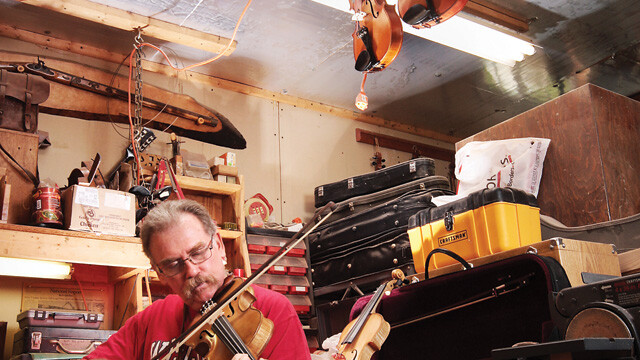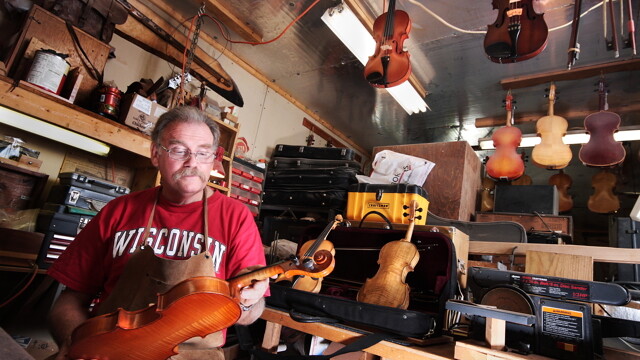Strung Out: local violin maker
local man turns passion for violins into full-time gig
Thom Fountain, photos by Andrea Paulseth |

bow across one of his stringed creations
inside his Plum Street workshop. Hootman
has been making violins since 1985.
Hootman is a third-generation instrument
craftsman.
Scott Hootman makes instruments. So did his father and his father’s father and his uncles and great uncles.
“The idea of building a mandolin or a violin or a cello or even a harp – it isn’t that there’s something mysterious about it,”Hootman said. “It can all be done. You just have to figure out how to do it.”
Hootman made his first violin in 1985, he said, and began learning how to play the instrument at the same time. For years he balanced his passion with various jobs, including having his own shop on Water Street in the 90s. Now though, after leaving his most recent job, he’s happy working for himself and making instruments full time.
“Every day is a day in paradise,”Hootman said about his decision. “I can’t think of anything that I would rather be doing with my time. This meets all the criteria of being valuable and important and creative and I love it.”
Hootman said he started by trying to reproduce the masters of violin making, such as the legendary Stradivarius, but after his first 15 or so he found his own method and styling.
Each violin is unique and one of the major contributions is the wood used. Hootman said his favorite wood to work with is a certain variety of white pine that has been lifted from the 80-foot depths of Lake Superior. All the resin from the logs, which were abandoned by loggers over 150 years ago, has washed away due to years under water, so the logs remain rot-free. The white pine produces a much softer, fuller tonal quality, Hootman said.

Wood choice doesn’t always stem solely from sound. A few wedges of a maple tree sit in the front corner of his workshop and Hootman said they come from a tree cut down by his father and grandfather some years ago. The tree provided wood for violins made by a variety of Hootman’s relatives and now himself, he said.
Another major factor to the violin’s sound and quality is matching the frequencies of the back and top pieces. To explain, Hootman excitedly ushered me over to a large box with a stereo set up next to it. He built this contraption himself.
Hootman has wired the stereo to the top and back pieces of a violin, turning the thin piece of wood into a speaker. He then plays a pitch through the amplifier and finds which frequency the board responds best to. By shaving off tenths of millimeters, Hootman can change the frequency, allowing him to match the two components perfectly.
The frequency the violin takes on alters its sound, Hootman said. While a lower frequency, which was common in older violins, produces darker, subtler tones, newer violins often have higher frequencies that are brighter and more “in your face.”
As a violinist gains experience, Hootman said they figure out exactly what they are looking for in an instrument and differing woods, frequencies and other intricacies help the musician find the perfect violin.
Hootman’s journey to where he is now, spending his days in the workshop behind his house, has worked similarly for his life.
“I know more of what I’m looking for,” Hootman said. “This is fitting real good.”
The Violin Maker makes handcrafted violins, violas, cellos, mandolins, mandolas, and dulcimers as well as repairs instruments. 839-7436. theviolinmaker@charter.net.




















